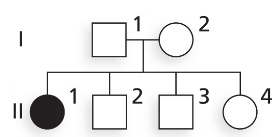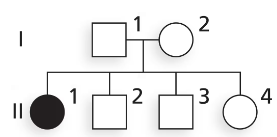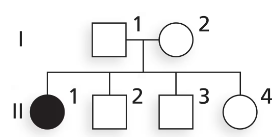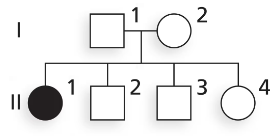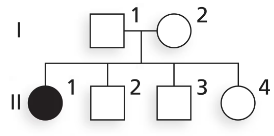 Back
BackProblem 45b
Domestic dogs evolved from ancestral gray wolves. Wolves have coats of short, straight hair and lack 'furnishings,' a growth pattern marked by eyebrows and a mustache found in some domestic dogs. In domestic dogs, coat variation is controlled by allelic variation in three genes. Recessive mutant alleles in the FGF5 gene result in long hair, while dogs carrying the dominant ancestral allele have short hair. Likewise, recessive mutant alleles in the KRT71 gene result in curly hair, whereas dogs with an ancestral dominant allele have straight hair. Dominant mutant alleles in the RSPO2 gene cause the presence of furnishings, while dogs homozygous for the ancestral recessive allele have no furnishings. A pure-breeding curly- and long-haired poodle with furnishings was crossed to a pure-breeding short- and straight-haired border collie lacking furnishings
If dogs of the F₁ generation are interbred, what proportions of genotypes and phenotypes are expected in the F₂?
Problem 46a
Alleles of the IGF-1 gene in dogs, encoding insulin-like growth factor, largely determine whether a domestic dog will be large or small. Dogs with an ancestral dominant allele are large, whereas dogs homozygous for the mutant recessive allele are small. Chondrodysplasia, a short-legged phenotype (as in dachshunds and basset hounds), is caused by a dominant gain-of-function allele of the FGF4 gene. The MSTN gene encodes myostatin, a regulator of muscle development. Dogs with a dominant ancestral allele of the MTSN gene have normal muscle development, while dogs homozygous for recessive mutants in the MTSN gene are 'double muscled' and have trouble running quickly. However, dogs heterozygous for the mutant allele run faster than either of the homozygotes.
You breed a pure-breeding small basset hound of normal musculature with a pure-breeding 'bully' whippet, a double-muscled large dog with normal legs.
What are the genotypes and phenotypes of the F₁ puppies?
Problem 46b
Alleles of the IGF-1 gene in dogs, encoding insulin-like growth factor, largely determine whether a domestic dog will be large or small. Dogs with an ancestral dominant allele are large, whereas dogs homozygous for the mutant recessive allele are small. Chondrodysplasia, a short-legged phenotype (as in dachshunds and basset hounds), is caused by a dominant gain-of-function allele of the FGF4 gene. The MSTN gene encodes myostatin, a regulator of muscle development. Dogs with a dominant ancestral allele of the MTSN gene have normal muscle development, while dogs homozygous for recessive mutants in the MTSN gene are 'double muscled' and have trouble running quickly. However, dogs heterozygous for the mutant allele run faster than either of the homozygotes.
You breed a pure-breeding small basset hound of normal musculature with a pure-breeding 'bully' whippet, a double-muscled large dog with normal legs.
If the F₁ of this cross is interbred, what proportion of the F₂ are expected to be fast runners and what proportion normal-speed runners?
Problem 47a
The accompanying pedigree shows a family in which one child (II-1) has an autosomal recessive condition. On the basis of this fact alone, provide the following information.
Using A for the dominant allele and a for the recessive allele, give the genotypes for I-1, I-2, and II-1.
Problem 47b
The accompanying pedigree shows a family in which one child (II-1) has an autosomal recessive condition. On the basis of this fact alone, provide the following information.
Using the same alleles, give the possible genotypes for II-2, II-3, and II-4.
Problem 47c
The accompanying pedigree shows a family in which one child (II-1) has an autosomal recessive condition. On the basis of this fact alone, provide the following information.
What are the probabilities for each of the possible genotypes for II-2, II-3, and II-4?
Problem 47d
The accompanying pedigree shows a family in which one child (II-1) has an autosomal recessive condition. On the basis of this fact alone, provide the following information.
What is the probability that all three of the children in generation II who have the dominant phenotype are Aa?
Problem 47e
The accompanying pedigree shows a family in which one child (II-1) has an autosomal recessive condition. On the basis of this fact alone, provide the following information.
What is the chance that among the three children in generation II who have the dominant phenotype, one of them is AA and two of them are Aa? (Hint: Consider all possible orders of genotypes.)
Problem 48a
A pea plant that has the genotype RrGgwwdd is crossed to a plant that has the rrGgWwDd genotype. The R gene controls round versus wrinkled seed, the G gene controls yellow versus green seed, the W gene controls purple versus white flower, and the D gene controls tall versus short plants. Determine the following;
What are the phenotypes of each plant?
Problem 48b
A pea plant that has the genotype RrGgwwdd is crossed to a plant that has the rrGgWwDd genotype. The R gene controls round versus wrinkled seed, the G gene controls yellow versus green seed, the W gene controls purple versus white flower, and the D gene controls tall versus short plants. Determine the following;
What proportion of the progeny are expected to have the genotype RrGGwwDd?
Problem 48c
A pea plant that has the genotype RrGgwwdd is crossed to a plant that has the rrGgWwDd genotype. The R gene controls round versus wrinkled seed, the G gene controls yellow versus green seed, the W gene controls purple versus white flower, and the D gene controls tall versus short plants. Determine the following;
What proportion of the progeny are expected to have the genotype rrggwwdd?
Problem 48d
A pea plant that has the genotype RrGgwwdd is crossed to a plant that has the rrGgWwDd genotype. The R gene controls round versus wrinkled seed, the G gene controls yellow versus green seed, the W gene controls purple versus white flower, and the D gene controls tall versus short plants. Determine the following:
What proportion of the progeny are expected to be round, yellow, purple, and tall?
Problem 49a
Go to the OMIM website (http://www.ncbi.nlm.nih.gov/omim) and locate the Search button at the top of the page. Use the search function to look up, one by one, the following three human hereditary diseases that are relatively common in certain populations: 'Tay–Sachs disease' (select OMIM number 272800 from the search results list); 'cystic fibrosis' (select OMIM number 602421 from the search results list); and 'sickle cell anemia' (select OMIM 603903 from the search results list). For each of these diseases, look through the information and provide the following details:
On which chromosome is the gene for the disease located?
Problem 49b
Go to the OMIM website (http://www.ncbi.nlm.nih.gov/omim) and locate the Search button at the top of the page. Use the search function to look up, one by one, the following three human hereditary diseases that are relatively common in certain populations: 'Tay–Sachs disease' (select OMIM number 272800 from the search results list); 'cystic fibrosis' (select OMIM number 602421 from the search results list); and 'sickle cell anemia' (select OMIM 603903 from the search results list). For each of these diseases, look through the information and provide the following details:
What gene is mutated in the disease?
Problem 49c
Go to the OMIM website (http://www.ncbi.nlm.nih.gov/omim) and locate the Search button at the top of the page. Use the Search function to look up, one by one, the following three human hereditary diseases that are relatively common in certain populations: 'Tay–Sachs disease' (select OMIM number 272800 from the search results list); 'cystic fibrosis' (select OMIM number 602421 from the search results list); and 'sickle cell anemia' (select OMIM 603903 from the search results list). For each of these diseases, look through the information and provide the following details:
Briefly describe the disease.
Problem 49d
Go to the OMIM website (http://www.ncbi.nlm.nih.gov/omim) and locate the Search button at the top of the page. Use the search function to look up, one by one, the following three human hereditary diseases that are relatively common in certain populations: 'Tay–Sachs disease' (select OMIM number 272800 from the search results list); 'cystic fibrosis' (select OMIM number 602421 from the search results list); and 'sickle cell anemia' (select OMIM 603903 from the search results list). For each of these diseases, look through the information and provide the following details:
In which population(s) does the disease most commonly occur?
Problem 50a
Select a human hereditary disease or condition you would like to know more about. Using the OMIM website (http://www.ncbi.nlm.nih.gov/omim), search for the disease and prepare a short synopsis of your findings. Include the following information:
The gene mutated in the disease and its chromosome location.
Problem 50b
Select a human hereditary disease or condition you would like to know more about. Using the OMIM website (http://www.ncbi.nlm.nih.gov/omim), search for the disease and prepare a short synopsis of your findings. Include the following information:
A description of the disease or condition.
Problem 50c
Select a human hereditary disease or condition you would like to know more about. Using the OMIM website (http://www.ncbi.nlm.nih.gov/omim), search for the disease and prepare a short synopsis of your findings. Include the following information:
Any available information about the population(s) in which the disease is most common.
Problem 51a
For a number of human hereditary conditions, genetic testing is available to identify heterozygous carriers. Some heterozygous carrier testing programs are community-based, often as part of an organized effort targeting specific populations in which a disease and carriers of a disease are relatively frequent. For example, carrier genetic testing programs for Tay–Sachs disease target Ashkenazi Jewish populations and sickle cell disease carrier testing programs target African American populations. The testing is usually free or available at minimal cost, the wait time for results is short, and the results are confidential and unavailable to third parties such as insurance companies. Neither the Tay–Sachs nor the sickle cell allele produces serious consequences for heterozygous carriers.
From a genetic perspective, what is the value of the information obtained by genetic testing of the type described?
Problem 51b
For a number of human hereditary conditions, genetic testing is available to identify heterozygous carriers. Some heterozygous carrier testing programs are community-based, often as part of an organized effort targeting specific populations in which a disease and carriers of a disease are relatively frequent. For example, carrier genetic testing programs for Tay–Sachs disease target Ashkenazi Jewish populations and sickle cell disease carrier testing programs target African American populations. The testing is usually free or available at minimal cost, the wait time for results is short, and the results are confidential and unavailable to third parties such as insurance companies. Neither the Tay–Sachs nor the sickle cell allele produces serious consequences for heterozygous carriers.
In a broader sense, what is the value of a community-based effort targeting specific populations for selected diseases?
Problem 51c
For a number of human hereditary conditions, genetic testing is available to identify heterozygous carriers. Some heterozygous carrier testing programs are community-based, often as part of an organized effort targeting specific populations in which a disease and carriers of a disease are relatively frequent. For example, carrier genetic testing programs for Tay–Sachs disease target Ashkenazi Jewish populations and sickle cell disease carrier testing programs target African American populations. The testing is usually free or available at minimal cost, the wait time for results is short, and the results are confidential and unavailable to third parties such as insurance companies. Neither the Tay–Sachs nor the sickle cell allele produces serious consequences for heterozygous carriers.
Do you personally think you would participate in the kind of carrier genetic testing described if you were a member of a population targeted for such testing?
Problem 52a
In humans, the ability to bend the thumb back beyond vertical is called hitchhiker's thumb and is dominant to the inability to do so (OMIM 274200). Also, the presence of attached earlobes is recessive to unattached earlobes (OMIM 128900).
Check your own phenotype and those of several friends or classmates.
Problem 52b
In humans, the ability to bend the thumb back beyond vertical is called hitchhiker's thumb and is dominant to the inability to do so (OMIM 274200). Also, the presence of attached earlobes is recessive to unattached earlobes (OMIM 128900).
Using all available and willing members of your family, or members of another family if yours is not easily accessible, trace the transmission of both traits in a pedigree. Use allelic symbols H and h for the thumb and E and e for earlobes, and identify the genotypes for each family member as completely as possible. Bring the pedigree back to share with your group.

